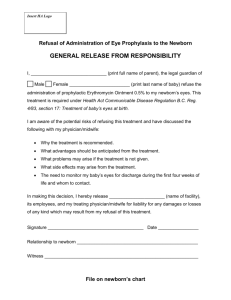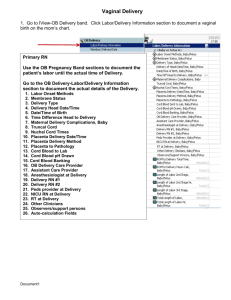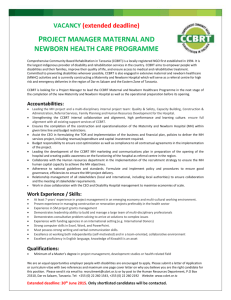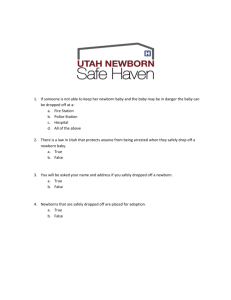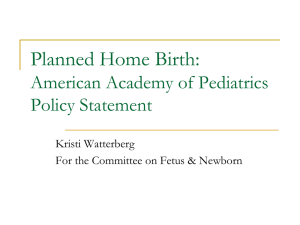Learning Guide
advertisement
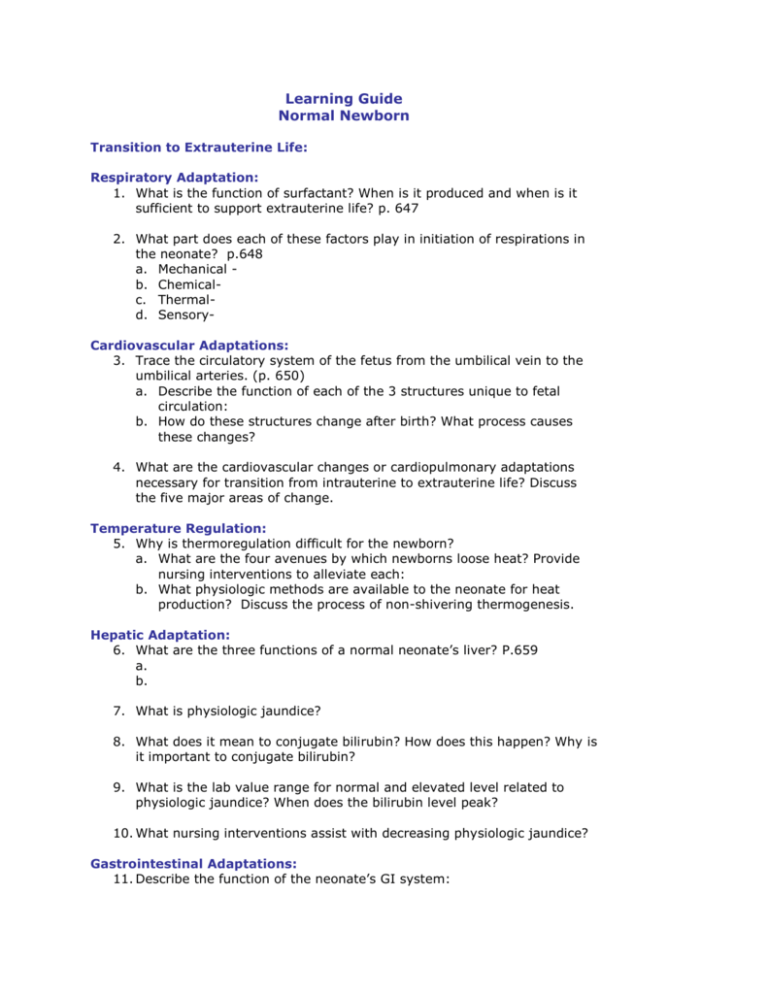
Learning Guide Normal Newborn Transition to Extrauterine Life: Respiratory Adaptation: 1. What is the function of surfactant? When is it produced and when is it sufficient to support extrauterine life? p. 647 2. What part does each of these factors play in initiation of respirations in the neonate? p.648 a. Mechanical b. Chemicalc. Thermald. SensoryCardiovascular Adaptations: 3. Trace the circulatory system of the fetus from the umbilical vein to the umbilical arteries. (p. 650) a. Describe the function of each of the 3 structures unique to fetal circulation: b. How do these structures change after birth? What process causes these changes? 4. What are the cardiovascular changes or cardiopulmonary adaptations necessary for transition from intrauterine to extrauterine life? Discuss the five major areas of change. Temperature Regulation: 5. Why is thermoregulation difficult for the newborn? a. What are the four avenues by which newborns loose heat? Provide nursing interventions to alleviate each: b. What physiologic methods are available to the neonate for heat production? Discuss the process of non-shivering thermogenesis. Hepatic Adaptation: 6. What are the three functions of a normal neonate’s liver? P.659 a. b. 7. What is physiologic jaundice? 8. What does it mean to conjugate bilirubin? How does this happen? Why is it important to conjugate bilirubin? 9. What is the lab value range for normal and elevated level related to physiologic jaundice? When does the bilirubin level peak? 10. What nursing interventions assist with decreasing physiologic jaundice? Gastrointestinal Adaptations: 11. Describe the function of the neonate’s GI system: 12. What is meconium and what is the significance of this for GI system? Urinary Adaptations: 13. What are the characteristics of the newborn urinary system? Immunologic Adaptations: 14. Differentiate between active acquired immunity and passive acquired immunity. Behavioral States of the Newborn: p 665 & 872-Chart 15. Describe the sleep/awake states of the newborn: a. Sleep States: i. Deep or quiet sleep ii. Active rapid eye movement/ light sleep b. Alert States: i. Drowsy ii. Wide awake/quiet alert iii. Active awake/ active alert iv. Crying 16. Which of the sleep/awake states is optimal for parental-infant interaction? 17. Describe the senses present in the newborn. Nursing Assessment of the Newborn Newborn Assessment: 18. Explain the criteria for assigning an Apgar Score: a. What time intervals is the Apgar score assigned? b. Which indicator is the priority Apgar score? 19. What Apgar score requires further intervention? Assessment of Physical Maturity Characteristics: 20. What characteristics of the newborn does the nurse assess to determine gestational age? 21. What is the average assessment finding for each of the following? Which one is priority for on-going assessment? a. Weightb. Lengthc. FOC22. Describe common assessment findings related to the skin of the newborn. Head: 23. Describe assessment of the fontanels and sutures present on newborn’s head. 24. Differentiate between caput succedaneum and cephalhematoma. Face: 25. What is included in assessment of the newborn’s eyes? 26. What do malformation or low-set ears indicate? 27. What should the nurse include when assessing the newborn’s mouth? Vital Signs: 28. What are the normal vital signs of the neonate? a. Pulse (which pulses should you include?) b. Respirationsc. Temperature d. Blood pressureAbdomen: 29. What assessment findings must the nurse note regarding the umbilical stump? a. Number of arteries=___ b. Number of veins=___ c. What is Wharton’s jelly? What is the purpose? Genitals: 30. Describe the normal genitalia of a newborn: a. What nursing technique must the nurse include when assessing the male neonate and expected normal findings and variations? b. What nursing technique must the nurse include when assessing the female neonate and expected normal findings and variations? Extremities: 31. What maneuvers are employed to assess the hips of a newborn? 32. Describe neurologic reflexes present in the newborn- what represents normal and abnormal findings? Legal Implications: 33. What are the legal implications and methods for newborn identification? P.470 34. What is the rationale for administration of medications to the newborn? Provide specific nursing interventions related to: p. 724 a. AquaMEPHYTON ® b. Erythromycin ointmentCircumcision: 35. What factors are involved in the parents’ decision to have their male newborn circumcised? 36. What assessments must the nurse include after the circumcision? 37. What are the specific nursing interventions for the two (2) types of circumcision? (including parent teaching)



